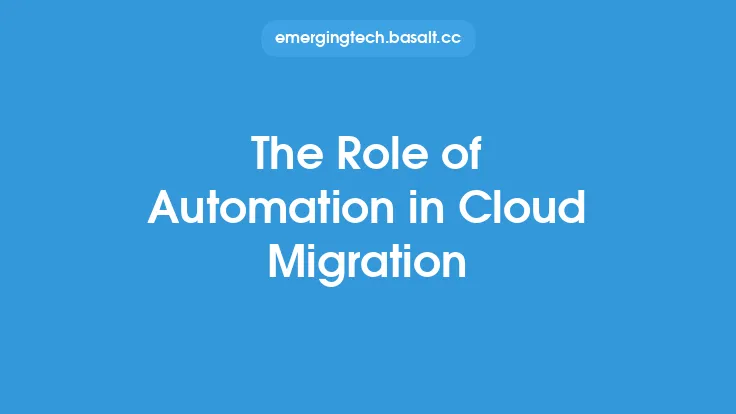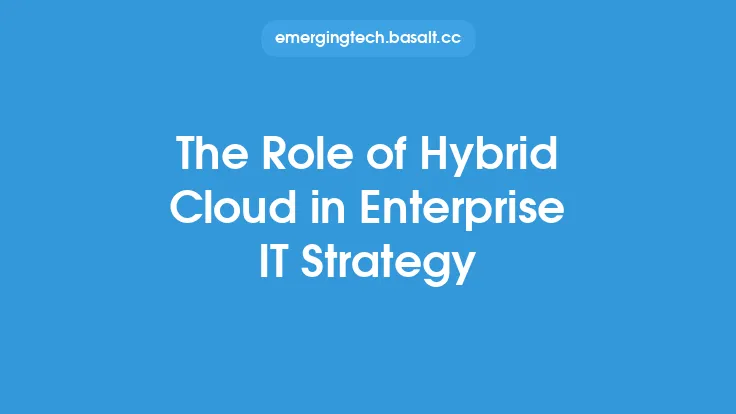In today's digital landscape, organizations are undergoing significant transformations to stay competitive and relevant. At the heart of this transformation is the adoption of cloud computing, which has revolutionized the way businesses operate, innovate, and deliver value to their customers. As companies navigate this new landscape, they are increasingly turning to multi-cloud strategies to drive their digital transformation efforts. This approach involves using multiple cloud services from different providers to meet various business needs, and it has become a crucial component of modern IT infrastructure.
Introduction to Multi-Cloud
A multi-cloud strategy allows organizations to leverage the strengths of different cloud providers, such as Amazon Web Services (AWS), Microsoft Azure, Google Cloud Platform (GCP), and IBM Cloud, among others. By using multiple clouds, businesses can avoid vendor lock-in, reduce dependence on a single provider, and increase flexibility and scalability. This approach also enables companies to choose the best cloud services for specific workloads, applications, or use cases, rather than being limited to a single provider's offerings.
Key Drivers of Multi-Cloud Adoption
Several factors are driving the adoption of multi-cloud strategies in digital transformation. One of the primary drivers is the need for flexibility and scalability. As businesses grow and evolve, their cloud requirements change, and a multi-cloud approach allows them to quickly scale up or down to meet these changing needs. Another driver is the desire to avoid vendor lock-in, which can limit a company's ability to innovate and respond to changing market conditions. Additionally, the use of multiple clouds enables businesses to take advantage of the unique features and services offered by different providers, such as AI and machine learning capabilities, data analytics, and cybersecurity solutions.
Technical Considerations for Multi-Cloud
From a technical perspective, implementing a multi-cloud strategy requires careful planning and consideration of several factors. One of the key challenges is ensuring interoperability between different cloud services and providers. This can be achieved through the use of standardized APIs, data formats, and protocols, such as RESTful APIs, JSON, and HTTP. Another technical consideration is security, as businesses must ensure that their data and applications are protected across multiple clouds. This can be achieved through the use of cloud-agnostic security solutions, such as identity and access management (IAM) systems, encryption, and firewalls.
Cloud Management and Orchestration
To effectively manage and orchestrate multiple cloud services, businesses need to implement cloud management platforms (CMPs) and cloud orchestration tools. These solutions enable companies to provision, deploy, and manage cloud resources across different providers, as well as monitor and optimize performance, security, and costs. Some popular cloud management and orchestration tools include CloudFormation, Terraform, and Ansible, which provide a unified interface for managing cloud resources and automating deployment and scaling.
Network and Connectivity Considerations
Another critical aspect of multi-cloud is network and connectivity. As businesses use multiple clouds, they need to ensure that their networks and connectivity infrastructure can support the flow of data and traffic between different cloud services and providers. This can be achieved through the use of software-defined networking (SDN) solutions, such as VPNs, SD-WAN, and network functions virtualization (NFV). These solutions enable companies to create a unified network fabric that spans multiple clouds and provides secure, reliable, and high-performance connectivity.
Data Management and Integration
Data management and integration are also essential considerations in a multi-cloud environment. As businesses use multiple clouds, they need to ensure that their data is consistent, accurate, and accessible across different cloud services and providers. This can be achieved through the use of data integration platforms, such as ETL (extract, transform, load) tools, data lakes, and data warehouses. These solutions enable companies to integrate data from different cloud sources, transform and process it, and load it into target systems for analysis and decision-making.
Conclusion
In conclusion, multi-cloud is playing a vital role in digital transformation, enabling businesses to drive innovation, flexibility, and scalability. By using multiple cloud services from different providers, companies can avoid vendor lock-in, reduce dependence on a single provider, and increase agility and responsiveness to changing market conditions. However, implementing a multi-cloud strategy requires careful planning and consideration of technical, security, and network factors. By understanding the key drivers, technical considerations, and best practices for multi-cloud, businesses can unlock the full potential of cloud computing and achieve their digital transformation goals.





